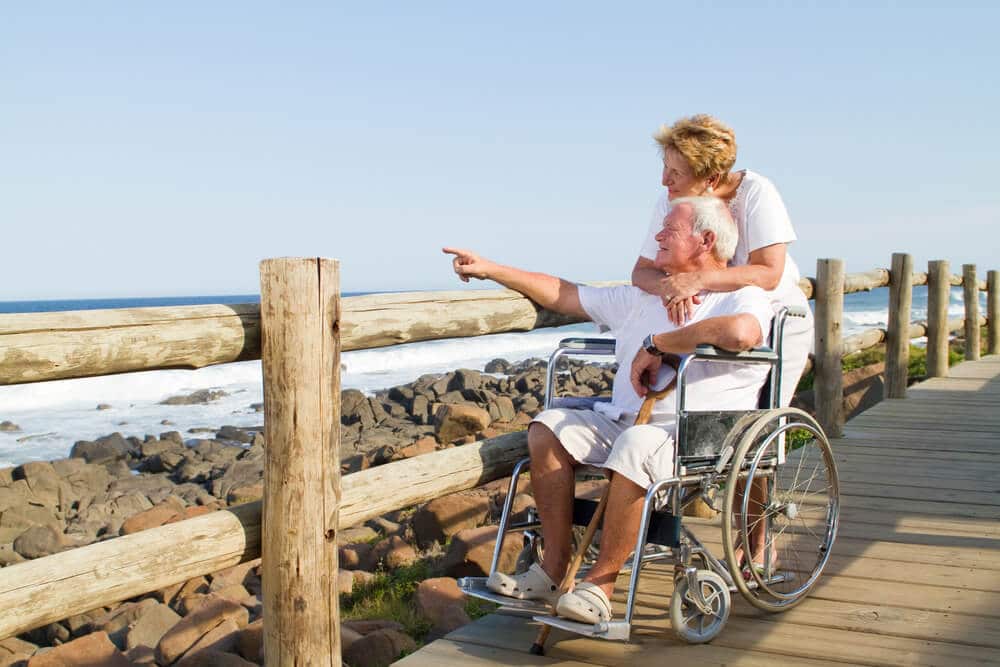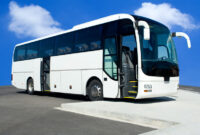Vacations for seniors with limited mobility needn’t be a distant dream. This guide explores accessible travel options, ensuring a comfortable and enriching experience for older adults with mobility challenges. We delve into suitable destinations, transportation methods, and accommodation choices, focusing on ease of access and creating memorable travel moments.
From carefully selected destinations boasting wheelchair ramps and accessible restrooms to meticulously planned itineraries incorporating rest and relaxation, we aim to empower seniors to explore the world without compromise. We’ll also address crucial planning aspects, such as pre-trip medical consultations and packing essentials, ensuring a smooth and enjoyable journey.
Accessible Travel Destinations
Planning a vacation with limited mobility requires careful consideration of accessibility features and destination suitability. Choosing the right location can significantly enhance the enjoyment and comfort of your trip. This section outlines ten destinations known for their accessibility, along with details to help you plan your perfect getaway.
Accessible Travel Destinations Table
The following table provides a summary of ten accessible destinations, highlighting key accessibility features and transportation options. Remember that accessibility features can vary between individual establishments, so it is always advisable to confirm details directly with hotels, attractions, and transportation providers before your trip.
| Destination | Country | Accessibility Features | Transportation Options |
|---|---|---|---|
| San Diego, California | USA | Wheelchair ramps, elevators in many buildings, accessible restrooms widely available, accessible beaches and boardwalks. | Accessible taxis and ride-sharing services, public transportation with wheelchair ramps and lifts. |
| Amsterdam, Netherlands | Netherlands | Excellent public transportation with low-floor trams and buses, many well-maintained paved walkways, accessible museums and attractions. | Well-developed public transportation system, accessible taxis and water taxis. |
| Kyoto, Japan | Japan | Many modern hotels with accessible rooms, accessible public transportation, and increasing accessibility in historical sites. | Efficient and accessible public transportation system, including trains and buses. |
| Barcelona, Spain | Spain | Many accessible hotels and restaurants, relatively flat terrain in many areas, accessible beaches. | Accessible taxis and public transportation, although some older areas may present challenges. |
| Vancouver, Canada | Canada | Good public transportation with accessible buses and SkyTrain, many accessible hotels and attractions. | Accessible public transportation, taxis, and ride-sharing services. |
| Berlin, Germany | Germany | Excellent public transportation system with accessible trains and buses, many accessible museums and historical sites. | Efficient public transportation, accessible taxis. |
| Lisbon, Portugal | Portugal | Many accessible hotels and restaurants, use of elevators and funiculars to navigate hills. | Accessible taxis and trams, although some areas with cobblestones can be challenging. |
| Orlando, Florida | USA | Widely accessible theme parks, hotels, and restaurants, with accessible transportation options. | Accessible taxis, ride-sharing services, and transportation within theme parks. |
| Rome, Italy | Italy | Increasing accessibility in many historical sites, accessible hotels and restaurants, although cobblestone streets are common. | Accessible taxis and public transportation, but some older areas may present challenges. |
| Sydney, Australia | Australia | Many accessible hotels and attractions, good public transportation system with accessible options. | Accessible trains, buses, and ferries, along with taxis and ride-sharing services. |
San Diego, California
San Diego boasts a pleasant Mediterranean climate with warm, dry summers and mild winters, making it ideal for year-round travel. The relatively flat terrain in many areas, coupled with its extensive network of accessible pathways and beaches, makes it exceptionally suitable for seniors with mobility issues. Key attractions like Balboa Park, with its numerous museums and gardens, offer accessible pathways and elevators. The Gaslamp Quarter, while historic, is largely accessible, and the city’s beaches provide wheelchair-accessible boardwalks. Seniors can enjoy leisurely strolls along the Embarcadero, taking in the waterfront views, or visit the San Diego Zoo, which features accessible pathways and exhibits.
Amsterdam, Netherlands
Amsterdam’s climate is temperate, with relatively mild summers and cool winters. The city is largely flat, making it easy to navigate, and its extensive canal system offers accessible boat tours. The well-maintained network of paved walkways and cycle paths makes it easy to explore, and public transportation is excellent, with low-floor trams and buses designed for wheelchair access. Many museums and attractions offer excellent accessibility features, ensuring that seniors can enjoy world-class art and culture without difficulty. Consider a canal cruise for a relaxing way to see the city’s iconic sights.
Kyoto, Japan
Kyoto experiences distinct seasons, with hot, humid summers and cool, dry winters. While some older areas may present challenges, Kyoto is increasingly improving its accessibility. Many modern hotels offer accessible rooms, and public transportation is generally efficient and accessible. Temples and gardens often have ramps and elevators where possible, though some may require assistance. Seniors can appreciate the beauty of traditional gardens and temples at a more leisurely pace, focusing on specific areas that offer easier access.
Barcelona, Spain
Barcelona enjoys a Mediterranean climate with warm, dry summers and mild, wet winters. While some areas feature hilly terrain, many central areas are relatively flat and easily navigable. The city offers a wealth of accessible attractions, including the iconic Sagrada Familia, Park Güell, and the beaches. Public transportation, while not universally accessible in all areas, is improving, and taxis are readily available. Seniors can enjoy strolling along Las Ramblas, visiting the many accessible museums, and relaxing on the beaches.
Vancouver, Canada
Vancouver’s climate is temperate, with mild, wet winters and warm, dry summers. The city is known for its stunning natural beauty and accessible urban environment. Its extensive network of accessible public transportation, including buses and the SkyTrain rapid transit system, makes getting around easy. Many hotels and attractions offer accessible rooms and features, and Stanley Park offers paved pathways suitable for wheelchairs. Seniors can enjoy scenic walks, explore the city’s vibrant neighborhoods, and take in the breathtaking views of the mountains and ocean.
Berlin, Germany
Berlin has a temperate climate with relatively cool summers and cold, snowy winters. The city boasts an excellent public transportation system, with accessible trains and buses, making it easy to navigate. Many historical sites and museums offer accessible entrances and facilities. The city’s flat terrain in many areas makes walking relatively easy. Seniors can explore iconic landmarks like the Brandenburg Gate and the Reichstag Building, as well as enjoy the city’s many parks and green spaces.
Lisbon, Portugal
Lisbon has a mild Mediterranean climate with warm, dry summers and mild, wet winters. The city’s hilly terrain can present some challenges, but the use of elevators and funiculars makes many areas accessible. Many hotels and restaurants are accessible, and the city’s charming trams offer a unique way to explore. Seniors can enjoy the city’s beautiful views, visit historical sites, and savor the delicious Portuguese cuisine in accessible establishments. Remember that cobblestone streets are common in older areas.
Orlando, Florida
Orlando has a subtropical climate with hot, humid summers and mild winters. The city is renowned for its theme parks, many of which are designed with extensive accessibility features, including ramps, elevators, and accessible rides. Hotels and restaurants are generally well-equipped for accessibility. Seniors can enjoy the magic of theme parks with specialized services often available to assist with mobility needs. Transportation within the parks is also generally accessible.
Rome, Italy
Rome enjoys a Mediterranean climate with hot, dry summers and mild, wet winters. While the city’s historic center is characterized by cobblestone streets, many areas are increasingly accessible. Many hotels and restaurants offer accessible facilities, and efforts are being made to improve accessibility at historical sites. Public transportation is available, though not always fully accessible. Seniors can explore iconic landmarks like the Colosseum and the Roman Forum, but careful planning and perhaps assistance may be needed in some areas.
Sydney, Australia
Sydney has a temperate climate with warm, dry summers and mild, wet winters. The city offers a good public transportation system with accessible options, including trains, buses, and ferries. Many hotels and attractions are accessible, making it a relatively easy city to navigate. Seniors can enjoy iconic sights like the Sydney Opera House and the Harbour Bridge, as well as the city’s beautiful beaches and parks.
Transportation Options
Planning transportation is crucial for seniors with limited mobility when traveling. Choosing the right mode of transport can significantly impact the enjoyment and comfort of their vacation. Careful consideration of accessibility features, cost, and convenience is essential for a smooth and stress-free trip.
Private Car Services
Private car services offer a high level of convenience and accessibility for seniors with limited mobility. These services typically provide vehicles equipped with ramps or lifts for wheelchairs, and drivers are often trained to assist passengers with boarding and disembarking. The cost varies depending on the distance, the type of vehicle, and the duration of the service. Booking can usually be done online or via phone, often requiring advance notice, especially for airport transfers. Expect to pay a premium compared to public transport, but the personalized service and convenience often justify the expense. For example, a one-way airport transfer in a major city might cost between $75 and $150, depending on distance and vehicle type.
Accessible Taxis
Many cities now offer accessible taxi services, although availability can vary. These taxis are equipped with ramps or lifts and may require pre-booking to ensure availability. The cost is usually comparable to standard taxis, but booking fees may apply. It’s important to confirm the taxi’s accessibility features before booking, as not all taxis are equipped to handle wheelchairs or other mobility aids. Checking with local taxi companies or using ride-hailing apps that filter for accessible vehicles is recommended. For instance, some ride-hailing apps allow users to specify wheelchair accessibility requirements when requesting a ride.
Specialized Airport Transfers
Airport transfers specifically designed for passengers with disabilities offer a seamless and stress-free travel experience. These services provide vehicles tailored to meet individual needs, including wheelchair-accessible vans and experienced drivers trained to assist passengers. The cost is typically higher than standard airport shuttles, but the added comfort and support are often worth the investment. Booking is usually done in advance, providing details about the passenger’s mobility needs and flight information. Many airlines and airports also offer assistance programs to help passengers with disabilities navigate the airport and transfer to their onward transportation.
Comparing Transportation Modes within Destinations
Public transportation such as buses and trains often offer accessible features like ramps, wheelchair lifts, and designated seating areas. However, accessibility varies greatly depending on the location and the age of the infrastructure. Older systems may lack the necessary adaptations, while newer systems are more likely to be accessible. Cost-effectiveness is generally higher than private options, but the convenience and ease of access may be lower, especially for individuals with significant mobility limitations. The comfort level is subjective and depends on factors like crowding and the duration of the journey. For instance, a senior with a walker might find navigating a crowded bus challenging, whereas a private car service would offer a more comfortable and less stressful experience.
Accommodation Choices
Choosing the right accommodation is crucial for a relaxing and enjoyable vacation, especially for seniors with limited mobility. The right choice can significantly impact comfort and ease of movement throughout the trip. Consider the accessibility features offered and how well they meet individual needs.
Several accommodation types cater specifically to the needs of seniors with mobility limitations, each offering varying levels of accessibility and amenities. Careful consideration of these options will ensure a comfortable and safe stay.
Accessible Hotel Accommodations
Many hotels now offer accessible rooms designed to accommodate guests with disabilities. These rooms often include a range of features designed to enhance mobility and independence.
- Roll-in showers with grab bars and adjustable showerheads.
- Wider doorways and hallways to accommodate wheelchairs or walkers.
- Lowered countertops and light switches.
- Emergency call buttons within reach.
- Accessible bathroom fixtures, including raised toilet seats and grab bars.
Accessible Resort Accommodations
Resorts, often known for their expansive layouts and numerous amenities, also provide accessible options for seniors with mobility limitations. However, it’s vital to verify the level of accessibility offered.
- Accessible rooms with features similar to those found in accessible hotels.
- Accessible pathways and ramps throughout the resort property.
- Accessible pools and spas with ramps or lifts.
- Accessible transportation within the resort, such as golf carts or shuttle services.
- Accessible dining options with appropriate seating and table heights.
Accessible Vacation Rental Accommodations
Vacation rentals, such as apartments or houses, can offer greater flexibility and space than hotels or resorts. However, ensuring accessibility requires careful planning and verification.
- Ramps or elevators for multi-story properties.
- Wide doorways and hallways.
- Grab bars in bathrooms.
- Accessible kitchen features, such as lowered countertops and accessible appliances.
- Clearly defined and well-lit pathways.
Booking and Verification of Accessibility Features
Booking an accessible room well in advance is essential, as availability is often limited. It’s equally crucial to verify the specific accessibility features available with the accommodation provider before making a reservation. Don’t hesitate to ask detailed questions about the features of the accessible room and request photographs if necessary. This proactive approach ensures a seamless and comfortable stay.
Always confirm the specific accessibility features available, such as the dimensions of doorways and the type of shower, to ensure they meet your individual needs.
Illustrative Examples
To further clarify the benefits of accessible travel for seniors with limited mobility, let’s examine specific examples of accommodations and tours designed with their needs in mind. These examples highlight how thoughtful design and planning can create truly enjoyable and enriching travel experiences.
Accessible Hotel Room: The “Serenity Suite” at the Ocean Breeze Inn
Imagine stepping into the “Serenity Suite” at the Ocean Breeze Inn. The room is bathed in soft, adjustable lighting; a combination of overhead LED panels offering bright, even illumination and bedside lamps with dimmer switches allows for personalized ambiance. The color palette is calming, utilizing soothing blues and greens, and the flooring is smooth, non-slip vinyl. Furniture is strategically placed to maximize space and ease of movement. A comfortable, high-backed armchair is positioned near a large window offering ocean views, while a spacious, adjustable-height bed sits against a wall, leaving ample room for wheelchair access and maneuverability. A well-lit, full-length mirror is mounted on a wall at a convenient height, and a nearby dresser features wide drawers and easy-to-grip handles. The entire room is designed to minimize obstacles and provide a sense of spaciousness.
The bathroom is equally impressive. A roll-in shower features a low threshold, grab bars strategically placed on all sides, and a fold-down shower seat. The toilet is raised for easier access, and there are handrails on either side. The sink is a comfortable height with plenty of counter space, and all fixtures are designed for easy use, with lever handles and ample space for maneuverability. The lighting is bright and even, eliminating shadows and enhancing visibility. Overall, the suite is designed to ensure comfort, safety, and independence for guests with limited mobility.
Accessible Guided Tour: Exploring Ancient Rome Without Limits
Consider a guided tour of Ancient Rome, specifically designed for individuals with limited mobility. The tour, titled “Exploring Ancient Rome Without Limits,” begins with a detailed briefing outlining the itinerary and the accommodations that will be made to ensure everyone’s comfort and safety. The tour operates at a slower pace, allowing ample time for sightseeing and rest. The guide utilizes a clear and concise communication style, ensuring everyone understands the historical context and significance of the sites visited.
Frequent rest stops are incorporated throughout the tour, with comfortable seating available at each location. The tour group is kept small to allow for personalized attention and assistance. The tour operator provides assistive devices, such as wheelchairs and walkers, as needed, and ensures all locations are wheelchair accessible. The itinerary prioritizes sites with smooth pathways and minimal inclines, and alternative routes are available for areas with significant elevation changes. For instance, instead of climbing the Spanish Steps, the group may opt for a less strenuous route, perhaps taking a scenic detour through a nearby park. The guide is knowledgeable about the use of assistive devices and readily offers support and assistance to those who need it. The entire tour is structured to provide a memorable and enjoyable experience for everyone, regardless of their physical limitations.
Final Wrap-Up
Planning a vacation that caters to the specific needs of seniors with limited mobility requires careful consideration, but the rewards are immense. By prioritizing accessibility and choosing destinations and activities thoughtfully, older adults can experience the joy of travel, creating lasting memories and enriching their lives. Remember, with the right planning and resources, an unforgettable vacation is within reach for everyone.



